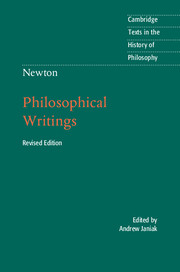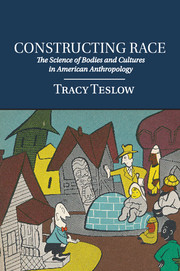Refine search
Actions for selected content:
10306 results in History of science: general interest
VII - Correspondence with G. W. Leibniz [1693/1712]
-
- Book:
- Newton: Philosophical Writings
- Published online:
- 05 August 2014
- Print publication:
- 14 August 2014, pp 140-152
-
- Chapter
- Export citation
Acknowledgments
-
- Book:
- Newton: Philosophical Writings
- Published online:
- 05 August 2014
- Print publication:
- 14 August 2014, pp vi-vi
-
- Chapter
- Export citation
IV - The Principia [1687, first edition]
-
- Book:
- Newton: Philosophical Writings
- Published online:
- 05 August 2014
- Print publication:
- 14 August 2014, pp 59-114
-
- Chapter
- Export citation
Introduction
-
- Book:
- Newton: Philosophical Writings
- Published online:
- 05 August 2014
- Print publication:
- 14 August 2014, pp vii-xxxv
-
- Chapter
- Export citation
Index
-
- Book:
- Newton: Philosophical Writings
- Published online:
- 05 August 2014
- Print publication:
- 14 August 2014, pp 189-198
-
- Chapter
- Export citation
IX - An Account of the Book Entitled Commercium Epistolicum [1715]
-
- Book:
- Newton: Philosophical Writings
- Published online:
- 05 August 2014
- Print publication:
- 14 August 2014, pp 165-168
-
- Chapter
- Export citation
Contents
-
- Book:
- Newton: Philosophical Writings
- Published online:
- 05 August 2014
- Print publication:
- 14 August 2014, pp v-v
-
- Chapter
- Export citation
Note on texts and translations
-
- Book:
- Newton: Philosophical Writings
- Published online:
- 05 August 2014
- Print publication:
- 14 August 2014, pp xlii-xliv
-
- Chapter
- Export citation
VIII - Correspondence with Roger Cotes [1713]
-
- Book:
- Newton: Philosophical Writings
- Published online:
- 05 August 2014
- Print publication:
- 14 August 2014, pp 153-164
-
- Chapter
- Export citation
I - “New Theory about Light and Colours”
-
- Book:
- Newton: Philosophical Writings
- Published online:
- 05 August 2014
- Print publication:
- 14 August 2014, pp 1-14
-
- Chapter
- Export citation
VI - Correspondence with Richard Bentley [1691–3]
-
- Book:
- Newton: Philosophical Writings
- Published online:
- 05 August 2014
- Print publication:
- 14 August 2014, pp 119-139
-
- Chapter
- Export citation
Further reading
-
- Book:
- Newton: Philosophical Writings
- Published online:
- 05 August 2014
- Print publication:
- 14 August 2014, pp xxxix-xli
-
- Chapter
- Export citation
II - Correspondence with Robert Boyle [1679]
-
- Book:
- Newton: Philosophical Writings
- Published online:
- 05 August 2014
- Print publication:
- 14 August 2014, pp 15-25
-
- Chapter
- Export citation
V - “An Account of the System of the World”
-
- Book:
- Newton: Philosophical Writings
- Published online:
- 05 August 2014
- Print publication:
- 14 August 2014, pp 115-118
-
- Chapter
- Export citation
III - De Gravitatione [date unknown]
-
- Book:
- Newton: Philosophical Writings
- Published online:
- 05 August 2014
- Print publication:
- 14 August 2014, pp 26-58
-
- Chapter
- Export citation
Chronology
-
- Book:
- Newton: Philosophical Writings
- Published online:
- 05 August 2014
- Print publication:
- 14 August 2014, pp xxxvi-xxxviii
-
- Chapter
- Export citation
A history of the Allais paradox
-
- Journal:
- The British Journal for the History of Science / Volume 48 / Issue 1 / March 2015
- Published online by Cambridge University Press:
- 08 August 2014, pp. 147-169
- Print publication:
- March 2015
-
- Article
- Export citation

Newton: Philosophical Writings
-
- Published online:
- 05 August 2014
- Print publication:
- 14 August 2014

Constructing Race
- The Science of Bodies and Cultures in American Anthropology
-
- Published online:
- 05 August 2014
- Print publication:
- 21 July 2014
Catholics, science and civic culture in Victorian Belfast
-
- Journal:
- The British Journal for the History of Science / Volume 48 / Issue 2 / June 2015
- Published online by Cambridge University Press:
- 01 August 2014, pp. 261-287
- Print publication:
- June 2015
-
- Article
- Export citation
